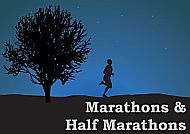On crossing the finishing line it’s tempting to say:
- Right – that’s it;
- I’m not walking another step;
- I’m going to guzzle gallons of water;
- And stuff my face with food just as soon as I can face it.
But you’ll feel a lot better if you apply a little science to the time the follows the end of the race.
Smart marathon recovery
If you plan ahead so that you can follow these post race marathon recovery tips, then your legs will thank you the next morning.
- Keep moving once you’ve stopped
- Eat
- Take a cooling bath
- Rehydration
- Go for a walk
This helps the muscles in the legs warm down.
A small carbohydrate-rich fat-free snack as soon as you can face it is best. Something like 200-400 calories is the right sort of amount.
You don’t necessarily have to face the horrors of an ice bath. A soak in cold tap water – even dangling your legs in a cold bath – will help.
Don’t overdo your rehydration. It’s better to take in water steadily throughout the period after the race to avoid diluting the electrolytes in your body – which would increase the risk of Hyponatremia.
Drinking isotonic sports drinks can help ensure that you maintain a healthy level of electrolytes and minerals too.
While you may feel you can’t take another step, once you have showered, eaten and feel better about the world, take a gentle walk if you can.
The next day
Sure, your body will ache like it’s rarely ached before and it will be tempting to put your feet up all day (and less tempting to go to work after a Sunday race).
It’s good idea to go for a 30-60 minute walk though.
The walk doesn’t need to be strenuous. Make it a gentle stroll if you like.
But the movement will help your legs get their act together far more effectively than sitting in front of the TV.
When to resume running
Assuming you want to carry on running, most runners find that they can resume very light running two or three days after a race.
